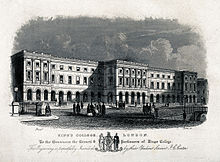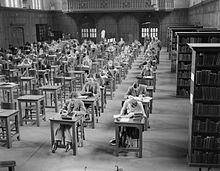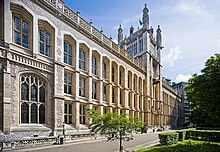loading...
Wednesday, 4 November 2015
King's College
Foundation

Ruler's College, so named to demonstrate the support of King George IV, was established in 1829 in light of the religious discussion encompassing the establishing of "London University" (which later got to be University College London) in 1827. London University was established, with the support of Utilitarians, Jews and non-Anglican Christians, as a mainstream organization, proposed to teach "the young of our ordinary rich individuals between the ages of 15 or 16 and 20 or later" giving its handle, "the heathen school in Gower Street".
The requirement for such an establishment was a consequence of the religious and social nature of the colleges of Oxford and Cambridge, which then taught exclusively the children of well off Anglicans. The mainstream way of London University was disliked by The Establishment, without a doubt, "the tempests of restriction which seethed around it debilitated to pulverize each flash of essential vitality which remained". Hence, the making of an adversary organization spoke to a Toryresponse to reassert the instructive estimations of The Establishment. All the more generally, King's was one of the first of a progression of foundations which happened in the mid nineteenth century as an aftereffect of the Industrial Revolutionand extraordinary social changes in England taking after the Napoleonic Wars. By ideals of its establishment King's has delighted in the support of the ruler, the Archbishop of Canterbury as its Visitor and amid the nineteenth century considered as a part of its official governors the Lord Chancellor, Speaker of the House of Commons and the Lord Mayor of London.

Bits of gossip in the press of a contending organization in the convention of the set up chapel showed up in 1827, however the thought was initially characterized ahead of schedule in 1828 by George D'Oyly, Rector of Lambeth, in a public statement to Sir Robert Peel, the then Home Secretary and Leader of the House of Commons. A plan developed amid the late spring of 1828 and an open meeting to dispatch King's, led by the Prime Minister, the Duke of Wellington, and went to by the Archbishops of York, Canterbury and Armagh, and two individuals from the Cabinet (Peel and the Earl of Aberdeen) was hung on 21 June 1828. A board of trustees of twenty-seven was delegated to raise reserves and to edge regulations and building arrangements, however the aggregate raised by membership was deficient. The Crown allowed the College a site lying between the Strand and the Thames and building started in 1829.
A regal sanction to join King's College was allowed by George IV on 14 August 1829, expressing the goal of the new Colleges:
...for the general education of youth in which the various branches of Literature and Science are intended to be taught, and also the doctrines and duties of Christianity... inculcated by the United Church of England and Ireland.— Royal charter incorporating King's College, 14 August 1829.
The administration of King's College was vested in a gathering comprising of nine authority governors, five of whom were pastors, eight life governors, a treasurer, and 24 different individuals from the Corporation. A few potential locales for the College were examined including Buckingham Palace and Regent's Park, however in the end the Treasury gave a site between the Strand and the Thames, running parallel to the yet unfinished Somerset Houseat a peppercorn rent in unendingness.
Duel in Battersea Fields, 21 March 1829

The Duke of Wellington's synchronous backing for an Anglican King's College and the Roman Catholic Relief Act, which was to prompt the conceding of full social liberties to Catholics, was tested by George Finch-Hatton, tenth Earl of Winchilsea, in mid 1829. Winchilsea and his supporters longed for King's to be liable to the Test Acts, similar to the colleges of Oxford and Cambridge, where just individuals from the Church of England could register, yet this was not Wellington's plan.
Winchilsea and around 150 different patrons pulled back their backing of the new school in light of Wellington's backing of Catholic liberation. Allegations against Wellington were distributed in a letter to The Standard daily paper on 14 March where Winchilsea accused the Prime Minister of trickiness in his backing for the new school. In a letter to Wellington he kept in touch with, "I have come to see the College as an instrument in a more extensive system intended to advance the Roman Catholic confidence and undermine the built up chapel." Winchilsea additionally charged the Duke to have at the top of the priority list "deceptive outlines for the encroachment of our freedom and the presentation of Popery into each division of the State".
The letter incited an incensed trade of correspondence and Wellington blamed Winchilsea for ascribing him with "offensive and criminal thought processes" in setting up King's College. At the point when Winchilsea declined to withdraw the comments, Wellington – by his own particular affirmation, "no supporter of dueling" and a virgin duellist – requested fulfillment in a challenge of arms: "I now call upon your lordship to give me that fulfillment for your behavior which a man of his word has a privilege to require, and which a noble man never declines to give."
The outcome was a duel in Battersea Fields on 21 March 1829. Winchilsea did not fire, an arrangement he and his second more likely than not settled on before the duel; Wellington focused on and let go wide to one side. Records vary regarding whether Wellington missed deliberately. Wellington, noted for his poor point, asserted he did, different reports more thoughtful to Winchilsea guaranteed he had planned to murder. Honor was spared and Winchilsea composed Wellington an apology."Duel Day" is still celebrated on the first Thursday following 21 March each year, stamped by different occasions all through the school, including reenactments.
19th century

Lord's opened in October 1831 with the pastor William Otter named as first important and speaker in heavenly nature. In spite of the aims of its originators and the house of prayer at the heart of its structures, the introductory outline allowed, "dissidents of various kinds to enter the school unreservedly". William Howley, the Archbishop of Canterbury, directed the opening service in which a sermon was given in the house of prayer by Charles Blomfield, the Bishop of London, on the subject of joining religious guideline with scholarly culture. The governors and the teachers, aside from the language specialists, must be individuals from the Church of England yet the understudies did not, however participation at Chapel was obligatory.
Lord's College was isolated into a senior office and a lesser division, otherwise called King's College School, which was initially arranged in the storm cellar of the Strand Campus. The Junior division began with 85 students and just three instructors, yet rapidly developed to 500 by 1841, exceeding its offices and driving it to migrate to Wimbledon in 1897 where it remains today, however it is no more connected with the College. Inside of the Senior office instructing was partitioned into three courses. A general course involved eternality, traditional dialects, arithmetic, English writing and history. Besides, there was the restorative course. Thirdly, different subjects, for example, law, political economy and cutting edge dialects, which were not identified with any methodical course of learn at the time and depended for their continuation on the supply of incidental understudies. In 1833 the general course was redesigned prompting the grant of the Associate of King's College (A.K.C.), the first capability issued by King's. The course, which concerns inquiries of morals and religious philosophy, is still honored today to understudies and staff who take a discretionary three-year course close by their studies.

The waterway facing was finished in April 1835 at an expense of £7,100, its fruition a state of King's College securing the site from the Crown. Not at all like those in the school, understudy numbers in the Senior office remained practically stationary amid the initial five years of the College's presence. Amid this time the restorative school was cursed by wastefulness and the separated loyalties of the staff prompting an enduring decrease in participation. A standout amongst the most critical arrangements was that of Charles Wheatstone as educator of Experimental Philosophy.
Right now, neither King's, nor "London University", had the capacity to give degrees, a specific issue for therapeutic understudies who wished to rehearse. Altering this circumstance was supported by the arrangement of Henry Broughamas Lord Chancellor, who was administrator of the governors of "London University". In this position he consequently turned into a legislative head of King's. In the understanding that the administration was unrealistic to give degree-recompensing forces on two organizations in London, arrangements prompted the schools unifying as the "College of London" in 1836, "London University" therefore getting to be University College. The governors at King's were insulted at the avoidance of godlikeness from the syllabus by the government college which was established as an analysing body and exhorted understudies to take the Oxford or Cambridge examinations, in any case, the force of the college to present degrees denoted a time of constrained development at King's.
In 1840, King's College opened King's College Hospital on Portugal Street close to Lincoln's Inn Fields, a territory made out of packed rookeries portrayed by neediness and ailment. The administration of the doctor's facility was later exchanged to the enterprise of the healing center set up by the King's College Hospital Act 1851, and in the long run moved to new premises in Denmark Hill, Camberwell in 1913. The arrangement in 1877 of Joseph Lister as educator of clinical surgery enormously profited the restorative school, and the presentation of Lister's disinfectant surgical routines picked up the doctor's facility a universal notoriety. In 1855 the College spearheaded night classes in London. In 1882 the King's College London Act corrected the constitution, the objects of the College reached out to incorporate the instruction of ladies.
20th century

The King's College, London Act 1903, nullified every remaining religiou tests for staff, aside from inside of the Theological office. The apocalypse War I saw a convergence of understudies, which strained existing offices to the point where a few classes were held in the Principal's home. An administration proposition to move the College's premises to Bloomsbury was considered, yet at long last rejected in 1925. Amid the Second World War most understudies and staff were cleared out of London to Bristol and Glasgow. The College structures were utilized by the Auxiliary Fire Service with various College staff, chiefly those then known as College workers, serving asfirewatchers. Parts of the Strand fabricating, the quadrangle, and the top of apse and recolored glass windows of the sanctuary endured bomb harm in the Blitz. Amid remaking, the vaults underneath the quadrangle were supplanted by a two-story research facility, which opened in 1952, for the bureaus of Physics and Civil and Electrical Engineering.
A standout amongst the most well known bits of exploratory examination performed at King's were the urgent commitments to the revelation of the twofold helix structure of DNA in 1953 by Maurice Wilkins and Rosalind Franklin, together withRaymond Gosling, Alex Stokes, Herbert Wilson and different partners at the Randall Division of Cell and Molecular Biophysics at King's.
Significant reproduction of King's started in 1966 after the distribution of the Robbins Report on Higher Education. Another square confronting the Strand outlined by E. D. Jefferiss Mathews was opened in 1972. Lord's experienced a few mergers with different organizations, including Queen Elizabeth College and Chelsea College of Science and Technology in 1985, the Institute of Psychiatry in 1997, and the United Medical and Dental Schools of Guy's and St Thomas' Hospitals were reincorporated in 1998 in the wake of getting to be free of the school at the establishment of the National Health Service in 1948. In 1998 Florence Nightingale's unique preparing school for medical attendants converged with the King's Department of Nursing Studies as the Florence Nightingale School of Nursing and Midwifery. That year King's gained the previous Public Record Office expanding on Chancery Lane and changed over it at an expense of £35 million into the Maughan Library, which opened in 2002
2001 to present


In July 2006, King's College London was conceded degree-honoring forces in its own particular right, rather than through the University of London, by the Privy Council. This force remained unexercised until 2007, while King's reported that all understudies beginning courses from September 2007 onwards would be honored degrees gave by King's itself, instead of by the University of London. The new testaments however still make reference to the way that King's is a constituent school of the University of London. Every single current understudy with no less than one year of study remaining were in August 2007 offered the choice of deciding to be honored a University of London degree or a King's degree. The main King's degrees were honored in summer 2008.
In 2007, for the second back to back year, understudies from the School of Law won the national round of the Philip C. Jessup International Law Moot Court Competition. The Jessup debatable is the biggest universal mooting rivalry on the planet. The King's group went ahead to speak to the UK as national champions.
In 2010 King's reported that 205 occupations were put at danger because of government financing cuts. Among the proposed trims was the UK's just seat of palaeography, two driving computational language specialists, and the division of Engineering, accepted to be the most seasoned in the UK (set up in 1838), starting a universal battle from scholastics.
In November 2010, King's dispatched a gathering pledges crusade to raise £500 million by 2015 for examination into five regions: malignancy, worldwide force, neuroscience and emotional well-being, administration and society and youngsters' health.Over £400 million has been raised as of March 2013. In 2011 the Chemistry office was revived after its conclusion in 2003.
In April 2011 King's turned into an establishing accomplice in the UK Center for Medical Research and Innovation, along these lines renamed the Francis Crick Institute, submitting £40 million to the undertaking.
In June 2014, King's declared arrangements for huge scale redundancies, possibly influencing up to 15% of staff in biomedical sciences and at the Institute of Psychiatry. Analysts noticed that numerous senior scholastics and understudies were exceptionally condemning of the arrangements, in light of the fact that they were being hurried through without satisfactory conference, undermined to leave understudies without sufficient showing staff, and would debilitate the exploration limit and harm the notoriety of the college. A representative for King's contended that the quantities of arranged redundancies were less than commentators asserted, however in this manner came in for further feedback, in light of the fact that staff had not been recounted this data. It was in this manner noticed that the repetition arrange additionally conflicted with unequivocal guidance in a charged report on the college's funds. Around the same time as these improvements, an article in the Times Higher Education noticed that, in an obviously disconnected advancement, King's was challenging an opportunity of data solicitation for subtle elements of pay rates of its top educators.
In October 2014, Ed Byrne supplanted Rick Trainer as Principal of King's, the recent having served for a long time.
On 10 March 2015, King's procured a 50-year lease for the Aldwych Quarter which incorporates the notable excellent Bush House building. Ruler's will involve Bush House and Strand House on a staged premise from September 2016, and adjoining structures King House and Melbourne House from 2025. Once King's takes full control of the four primary structures, the Aldwych Quarter will give roughly 300,000 square feet of extra space for understudy study and social space, new showing offices and scholastic convenience.